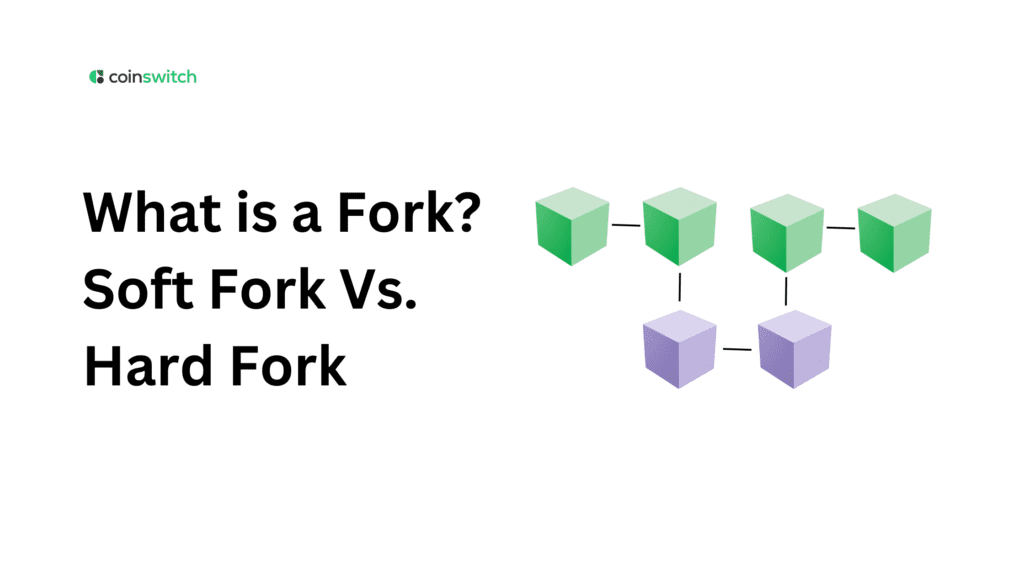Introduction
Blockchains are designed to be immutable; once data is written, it cannot be changed. But blockchains evolve. Sometimes they diverge. That divergence is called a fork. But forks are more than technical splits; they are forks in philosophy, governance, community, and direction. In other words, a blockchain fork is a divergence in a blockchain network’s protocol, creating two separate versions of the blockchain.
When you see headlines like “hard fork coming,” “Ethereum’s 2.0 fork,” or “Bitcoin Cash forked,” it’s not just hype. It’s a pivotal moment. A fork can reshape which rules hold, which coins live, and which communities win. The question “what is fork” is fundamental if you want to follow blockchain technology with clarity, and avoid confusion or loss when the chain splits.
In this blog post, we’ll explain exactly what a fork is, then explore why forks are so critical, dig into why they happen, examine how they continue to shift the crypto landscape, and finally wrap up with reflections on how to navigate forks well.
Why Is This Important?
Understanding forks matters at three levels: technical, financial, and strategic.
From a technical standpoint, a fork changes the rules of the blockchain, its consensus, transaction format, block size, gas model, or features. Users and nodes must adapt. If they don’t, they may be stuck on an obsolete chain or lose access.
Financially, blockchain hard forks can create new coins by splitting a blockchain into two distinct versions. If you held the original chain before the fork, you might end up with tokens on both branches. These new coins can be worth something, worthless, or even harmful. Some forks draw speculators hoping to cash in. But others damage network value or create confusion. Knowing what is fork helps you understand whether a fork is likely to reward or penalize holders.
Strategically, forks test governance and community. Who gets to decide change? Which vision prevails? Which side attracts developers, users, and exchanges? Forks aren’t just code; they’re ideological and social experiments.
Without understanding forks, you risk being surprised when your wallet shows two coin balances or when your favorite blockchain changes rules overnight. If you understand forks, you can anticipate, plan, and protect your assets.
Why Do Forks Occur?
Forks arise because blockchains evolve, communities diverge, or errors need to be fixed. Let’s break down the main causes.
Protocol Upgrades & Feature Changes
As blockchains grow, they need new features. Hard forks allow major upgrades that break old rules, introducing new transaction logic, performance improvements, or consensus tweaks. Soft forks may adjust rules in a backward-compatible way.
A notable example of a soft fork is Segregated Witness (SegWit) in Bitcoin. It altered how signature data stores to reduce transaction malleability and increase effective block capacity without splitting the chain. That was a backward-compatible protocol upgrade.
In contrast, if the change is incompatible with old software, it becomes a hard fork.
Community Disagreement & Governance Splits
Sometimes, developers, miners, or node operators disagree on growth direction, block size, fees, strategy, decentralization vs. performance. These ideological rifts often trigger forks. When one faction pushes changes that the other cannot support, a split becomes inevitable.
The 2017 Bitcoin/Bitcoin Cash fork is a prime example. Disagreement over whether to increase block size vs. keeping smaller blocks led to a hard fork, splitting the chain.
Emergency Fixes & Reversals
When vulnerabilities or exploits strike, some blockchains fork to fix or roll back the state. A fork can reverse transactions or patch bugs. But that’s controversial because it challenges immutability.
The 2016 DAO hack on Ethereum led to such a fork. The Ethereum community chose to revert to the pre-exploit state, creating Ethereum (ETH) and leaving hardcore “no rollback” supporters to stick with Ethereum Classic (ETC).
Experiments & Spin-Offs
Some projects don’t evolve; they replicate. They fork an existing codebase and tweak policies, tokenomics, consensus, etc. These forks are new experiments. Many never last, but a few capture interest.
Litecoin, for instance, originated as a fork of Bitcoin in 2011. Its changes included using the scrypt algorithm instead of SHA-256, faster block times, and a different token supply.
Bitcoin has dozens of forks over its history. Examples include Bitcoin Gold, Bitcoin SV, and many smaller ones.
Read More: HODL: Crypto Strategy of “Hold on for Dear Life” Explained
How Are Forks Continuing to Change the Crypto Landscape?
Forks are shaping how crypto evolves. They push innovation, competition, and adaptation.
Enabling Upgrades That Push Boundaries
Blockchains often reach limits in terms of throughput, decentralization, and gas costs. Forks enable radical rethinking. For example, forks can enable more efficient transaction formats, introduce new scripting languages, or fundamentally overhaul consensus systems (such as Proof of Stake, sharding, or zero-knowledge proof upgrades).
Forks allow blockchains to pivot. Without forks, adaptation to new security threats, scaling challenges, or governance needs becomes much harder.
Fueling Network Competition
When a major chain forks, it gives birth to alternative networks. For example, Bitcoin Cash forked with a vision of bigger blocks and more usable transaction throughput. Each fork becomes a competitor in its own right, trying to win adoption, developer mindshare, and infrastructure support.
These forks fragment the landscape but also fuel more choices. Users can choose chains aligned with their priorities (speed, low gas, decentralization, etc.).
Testing Governance & Community Strength
When a fork decision looms, community governance is put to the test. Who shows up to vote? Which nodes upgrade? Which exchanges support the new chain? Which wallets add support? These decisions shape power, influence, and legitimacy.
The fork lineage of Bitcoin (XT, Classic, Unlimited, Cash) illustrates how communities repeatedly debate direction and vision, sometimes resulting in the creation of multiple chains.
Read More: What is an NFT? Non-Fungible Tokens Explained
Driving Infrastructure Evolution
Each fork demands wallet upgrades, exchange support, node software updates, and community education. Infrastructure must adapt. Some forks drive wallet innovation, multi-chain bridges, replay protection, and cross-chain tools.
They force entire ecosystems to evolve. For instance, forks often include replay protection mechanisms, ensuring that transactions on one chain aren’t misinterpreted on the other.
Pruning Failures & Maintaining Quality
Many forks fail. Some wander in obscurity and fade. Code abandonment, lack of support, and security issues remove weaker forks from the field. That natural culling forces teams to build sustainable, valuable chains. Research on forked projects shows many clones never patch security vulnerabilities or evolve.
Case in point: Hundreds of Bitcoin forks exist, but only a few are active or meaningful today.
Conclusion
A fork is more than a technical event; it’s a turning point, a test of consensus, and a window into what blockchain communities believe in. Understanding what is fork helps you read the shifting landscape, know where value moves, and manage risk when chains split.
Forks occur because blockchains evolve, communities diverge, or emergent problems demand change. They drive competition, innovation, and governance. They force infrastructure to adapt and weed out weaker attempts.
When a fork looms, ask: which direction do the developers, nodes, exchanges, and users want? Which chain will win adoption? Will your assets carry over? Will the new chain have support? Because fork decisions are rarely smooth, they come with surprises.
Ultimately, forks demonstrate that blockchains aren’t frozen relics; they are living systems. They evolve. They argue. They split. And in those splits, we see the heart of decentralized truth.
FAQs
1. What is the definition of a fork?
A fork refers to a split or divergence in a system, process, or codebase where a new path is created alongside the original. In technology and blockchain, this often means a change in the rules or structure that leads to two distinct outcomes. The concept applies in software development, blockchain protocols, and even in project decisions where paths split due to differing objectives.
2. What is a fork in blockchain?
In blockchain, a fork is a change in the underlying code that creates a new version of the chain. It happens when network participants disagree on rules—like how transactions should be validated or how rewards are distributed. Some forks are soft (backward compatible), others are hard (permanent splits). Bitcoin Cash, for instance, was born from a hard fork of Bitcoin.
3. What is a fork in trading?
In trading, especially crypto trading, a fork usually refers to a blockchain split that creates a new coin. When this happens, traders might receive tokens from the new chain, impacting their portfolios. Forks often trigger volatility, speculation, and shifts in trading behavior, as markets react to the potential value or future use of the new asset.








